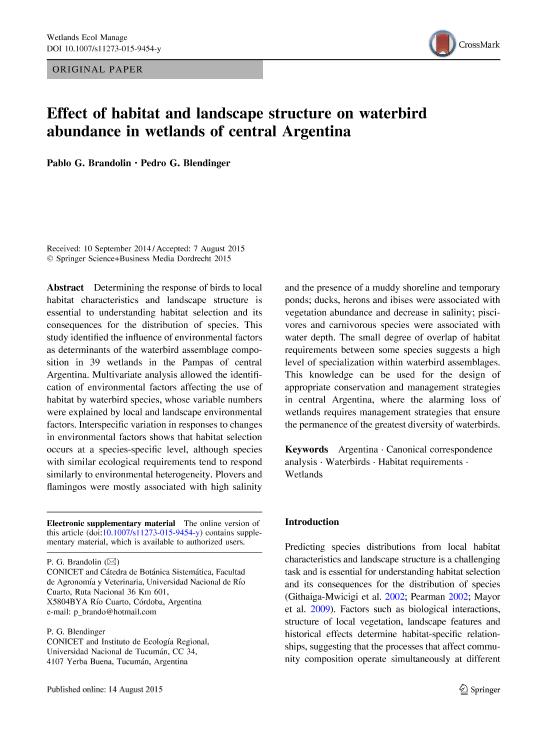Mostrar el registro sencillo del ítem
dc.contributor.author
Brandolin, Pablo Germán

dc.contributor.author
Blendinger, Pedro Gerardo

dc.date.available
2019-05-24T14:00:12Z
dc.date.issued
2016-02
dc.identifier.citation
Brandolin, Pablo Germán; Blendinger, Pedro Gerardo; Effect of habitat and landscape structure on waterbird abundance in wetlands of central Argentina; Springer; Wetlands Ecology and Management; 24; 1; 2-2016; 93-105
dc.identifier.issn
0923-4861
dc.identifier.uri
http://hdl.handle.net/11336/77033
dc.description.abstract
Determining the response of birds to local habitat characteristics and landscape structure is essential to understanding habitat selection and its consequences for the distribution of species. This study identified the influence of environmental factors as determinants of the waterbird assemblage composition in 39 wetlands in the Pampas of central Argentina. Multivariate analysis allowed the identification of environmental factors affecting the use of habitat by waterbird species, whose variable numbers were explained by local and landscape environmental factors. Interspecific variation in responses to changes in environmental factors shows that habitat selection occurs at a species-specific level, although species with similar ecological requirements tend to respond similarly to environmental heterogeneity. Plovers and flamingos were mostly associated with high salinity and the presence of a muddy shoreline and temporary ponds; ducks, herons and ibises were associated with vegetation abundance and decrease in salinity; piscivores and carnivorous species were associated with water depth. The small degree of overlap of habitat requirements between some species suggests a high level of specialization within waterbird assemblages. This knowledge can be used for the design of appropriate conservation and management strategies in central Argentina, where the alarming loss of wetlands requires management strategies that ensure the permanence of the greatest diversity of waterbirds.
dc.format
application/pdf
dc.language.iso
eng
dc.publisher
Springer

dc.rights
info:eu-repo/semantics/openAccess
dc.rights
Atribución-NoComercial-CompartirIgual 2.5 Argentina (CC BY-NC-SA 2.5 AR)
dc.rights.uri
https://creativecommons.org/licenses/by-nc-sa/2.5/ar/
dc.subject
Argentina
dc.subject
Canonical Correspondence Analysis
dc.subject
Habitat Requirements
dc.subject
Waterbirds
dc.subject
Wetlands
dc.subject.classification
Otras Ciencias Biológicas

dc.subject.classification
Ciencias Biológicas

dc.subject.classification
CIENCIAS NATURALES Y EXACTAS

dc.title
Effect of habitat and landscape structure on waterbird abundance in wetlands of central Argentina
dc.type
info:eu-repo/semantics/article
dc.type
info:ar-repo/semantics/artículo
dc.type
info:eu-repo/semantics/publishedVersion
dc.date.updated
2019-05-23T19:12:18Z
dc.identifier.eissn
1572-9834
dc.journal.volume
24
dc.journal.number
1
dc.journal.pagination
93-105
dc.journal.pais
Alemania

dc.journal.ciudad
Berlin
dc.description.fil
Fil: Brandolin, Pablo Germán. Universidad Nacional de Rio Cuarto. Facultad de Agronomia y Veterinaria. Departamento de Biología Agrícola. Cátedra de Botanica Sistematica; Argentina. Consejo Nacional de Investigaciones Científicas y Técnicas. Centro Científico Tecnológico Conicet - Córdoba; Argentina
dc.description.fil
Fil: Blendinger, Pedro Gerardo. Consejo Nacional de Investigaciones Científicas y Técnicas; Argentina. Universidad Nacional de Tucumán. Facultad de Ciencias Naturales e Instituto Miguel Lillo. Laboratorio de Investigaciones Ecológicas de las Yungas; Argentina
dc.journal.title
Wetlands Ecology and Management

dc.relation.alternativeid
info:eu-repo/semantics/altIdentifier/doi/http://dx.doi.org/10.1007/s11273-015-9454-y
dc.relation.alternativeid
info:eu-repo/semantics/altIdentifier/url/https://link.springer.com/article/10.1007%2Fs11273-015-9454-y
Archivos asociados
